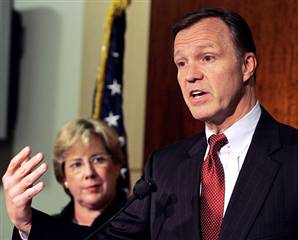Journalist-Source Relationships: Better Understanding is Needed
 In order for the media’s dynamic as a trusted information source to succeed, it is imperative that the public have confidence in the information news organizations disseminate. According to findings published in the 2006 Edelman Trust Barometer, which measures public trust levels in companies and business sectors, American business media ranks high in confidence: sixty-six percent of the public finds information in business newspapers and magazines to be credible. Although the Barometer does not make a significant query into exploring why the public’s mindset warrants this statistic, business news organizations’ attempts to be transparent in disclosing various conflicts of interest certainly contribute to the public trust they enjoy.
In order for the media’s dynamic as a trusted information source to succeed, it is imperative that the public have confidence in the information news organizations disseminate. According to findings published in the 2006 Edelman Trust Barometer, which measures public trust levels in companies and business sectors, American business media ranks high in confidence: sixty-six percent of the public finds information in business newspapers and magazines to be credible. Although the Barometer does not make a significant query into exploring why the public’s mindset warrants this statistic, business news organizations’ attempts to be transparent in disclosing various conflicts of interest certainly contribute to the public trust they enjoy. In a recent speech given in June to the New York Financial Writers Association, the U.S. Securities and Exchange Commission (SEC) Chairman Christopher Cox sugg ested that journalists’ jobs “would be a lot easier if lawmakers and regulators didn’t make things so needlessly complicated in the first place.” His statement, of course, is true: if financial journalists were not required to report conflicts of interest – whether those are their own, their employer’s or the company on which they are reporting – they would have an easier job. But would this forgone transparency benefit the public? No. In order to truly be informed and fully grasp a situation, the public relies on journalists to be faithful in communicating any underlying relationship. Journalists working in the business field have a heightened responsibility to accurately report these relationships as their articles influence a vast amount of market moves.
ested that journalists’ jobs “would be a lot easier if lawmakers and regulators didn’t make things so needlessly complicated in the first place.” His statement, of course, is true: if financial journalists were not required to report conflicts of interest – whether those are their own, their employer’s or the company on which they are reporting – they would have an easier job. But would this forgone transparency benefit the public? No. In order to truly be informed and fully grasp a situation, the public relies on journalists to be faithful in communicating any underlying relationship. Journalists working in the business field have a heightened responsibility to accurately report these relationships as their articles influence a vast amount of market moves.
Effective business beat reporters need to cultivate relationships with sources closely connected to their stories. These almost obligatory relationships are often formed with company employees, employees of competitors and stock analysts. Each of these groups of sources has an underlying and often ulterior motive in providing information to journalists. Above all else, corporate employees, whether they are public relations spokespersons or the chairpersons of the board, seek positive coverage for their company. Analysts, removed a greater degree from the corporation, also must be scrutinized as their job depends on maintaining relationships with a firm. Seasoned journalists understand that analysts who issue very negative reports about a company may not be provided with non-public information anymore. Journalists also consult hedge fund managers as sources. CNN’s Lou Dobbs and Gene Marcial of Business Week, who have reported on the r umor-like status of stock takeovers and mergers in the past, have been accused of being baited by short-sellers. Once Dobbs or Marcial published a story about the stock and the general public enacted upon that information, short-sellers would sell off their stock and profit tremendously. While financial journalists on the whole are aware of the problematic partnerships they forge with sources, there are few alternative avenues to gather information needed for almost every breaking story.
umor-like status of stock takeovers and mergers in the past, have been accused of being baited by short-sellers. Once Dobbs or Marcial published a story about the stock and the general public enacted upon that information, short-sellers would sell off their stock and profit tremendously. While financial journalists on the whole are aware of the problematic partnerships they forge with sources, there are few alternative avenues to gather information needed for almost every breaking story.
The obvious violations of ethics and SEC mandates are easy to correct in business reporting. News organizations routinely will not allow a journalist with explicit conflicts to report on a certain company or business sector. These types of conflicts are usually those that the SEC rightly feels might encourage a journalist to report something that would directly affect a specific corporation’s stock, such as a spouse’s top position at a financial firm or involvement with a particular corporation as a stockholder. The more subtle journalist-source relationships are not as easily identified as potential conflicts of interest. It is the uncertain bounds of these relationships that the SEC and news organizations need to help journalists clarify.

0 Comments:
Post a Comment
<< Home